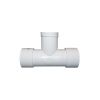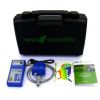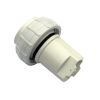Eno Scientific WS 131 Flow Meter
Features
- Flow meter housings are available in 5 sizes
- Data can be displayed and logged by the Well Sounder 2010 PRO
- Includes the total flow, flow rate and recovery rate functions
- Free ground shipping
- Expedited repair and warranty service
- Lifetime technical support
- More
Overview
The Eno Scientific WS 131 features a simple design consisting of a PVC housing and an electronic sensor module that easily attaches to the housing using a hand-tightened ring nut. Once the sensor is installed, it transmits electrical pulses that are generated as water moves past the paddle wheel. The amount of water volume that passes through the pipe can be interpreted by an Eno Scientific water level meter like the Well Sounder 2010 Pro. During inactivity, the sensor can be removed and replaced with an inexpensive plug with the same kind of hand-tightened ring nut concept.
Design
Flow meter housings are available in various sizes. The 1", 1.5" and 2" housings are in-line tees made with Type 1 PVC with sockets for schedule 40 PVC pipes, and compatible with common PVC piping and adhesives. The 3" and 4" housings are saddle tees made of Type 1 PVC which clamps onto schedule 40 PCV pipes. The paddle wheel is made of a tough polyethylene material and is the only object subject to wear in the entire system. In the case of highly abrasive water flow, the paddle wheel may experience wear with time but is easily replaced without tools.
Mechanics
The electronic flow sensor operates off a 5-24 VDC power supply and provides an output voltage on the signal line, which switches between Vin and ground as the paddle wheel turns. Data collection is configurable by either plugging a ready-to-plug cable into the Well Sounder 2010 Pro, or with three-wire leads for connection to other data logging devices. An accessory splitter is necessary for the Well Sounder to monitor and log data from both the flow meter and the probe.
- Materials
- Housings: Type 1 PVC
- Paddle Wheel: HDPE
- O-Ring: Buna N
- Axle: Tungsten Carbide
- Plumbing & Physical
- Pipe Size: Schedule 40 PVC
- Test Pressure: 240 psi
- Temperature: 32 – 140° F (0 – 60° C)
- Dimensions
- 1" Housing: 5.75 x 4.5 x 2.4″
- 1.5" Housing: 6.25 x 5.25 x 2.4″
- 2" Housing: 7.11 x 5.75 x 3″
- 3" Housing: 5.0 x 5.5 x 6.5″
- 4" Housing: 5.0 x 6.5 x 7.5″
- Clearance for Sensor Removal: 3.5”
- Electrical
- Power: 5 – 24V at 500 uA max
- Output Signal: Pull-to-ground (+V – 0V)
- Pulse Width: ~5mS
- Frequency: 0.3 – 200 Hz
- (1) Flow meter
In The News
Three Decades of Research at Acton Lake
A multi-disciplinary team at Miami University, Ohio, has been studying the environmental change at Acton Lake for over three decades. Using three different NexSens buoys over this time, the team has an incredible archive of data that is helping build a picture of Acton’s past, present, and future. Until recently, a NexSens CB-50 buoy was used alongside other environmental monitoring at Acton Lake. In May 2025, the Miami team deployed a new XB-200 buoy , future-proofing their ongoing monitoring using real-time buoy systems. Acton Lake, a small hypereutrophic reservoir in southwest Ohio, covers 2.4km² and has a maximum depth of about 8m. The dam was built in 1956, and the lake has a large agricultural watershed.
Read MoreSource Water Monitoring in Albany, New York: Tracing Water Quality throughout Tributaries
Thousands of US cities pull their drinking water from natural source waters like reservoirs, rivers, and streams, making overall watershed health a key consideration for water providers. In Albany, New York, the Albany Department of Water and Water Supply delivers drinking water to over 100,000 residents as well as monitors and manages the larger drinking water supply watershed. Hannah Doherty, Environmental Specialist at the Albany Department of Water and Water Supply , spends her days working with a small team to monitor the drinking supply and the connected water bodies. Doherty explains, “We’re the first to encounter the water that ends up being the drinking water.
Read MoreWildfire Prevention in the Sierra Nevada Region with the Yuba Watershed Institute
Though recent wildfires have sparked new conversations about wildfire management and response, groups like the Yuba Watershed Institute have been monitoring the forests and water resources of the Sierra Nevada region for decades, managing approximately 5,000 acres of land with the Bureau of Land Management (BLM) and about 7,000 acres in private land partnerships. The goal of the Institute is to work with local communities and land agencies to improve watershed and forestry management through informed practices and public outreach. The goals of the Yuba Watershed Institute are three-fold: Improve the ability of fire suppression agencies like the California Department of Forestry and Fire Protection ( CAL FIRE ) and the US Forest Service.
Read More
























